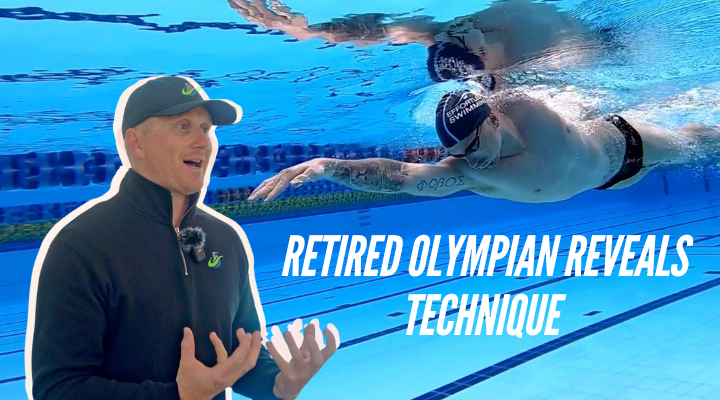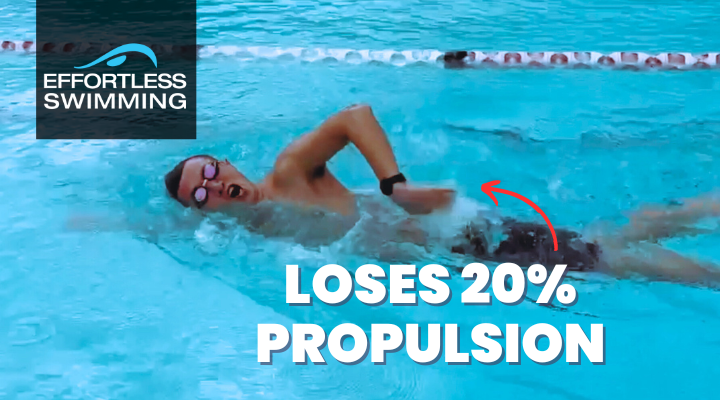This swimmer is not swimming in the front quadrant ie her lead arm is pulling too early AND she is getting stuck at her hip during the exit. The three main causes here are:
1. Too much tension in her hands and forearms
2. Not enough reach forwards before her catch
3. Too deep in the pull which is making it hard to for her to exit her hand
Transcription:
Hi Brenton Ford, welcome to Feedback Friday. In today’s episode, we have a swimmer who sent us their front view here. And one of the key things we’re looking at here is the timing. If she can adjust the timing of those strokes, she going to be getting so much more out of each stroke that she takes.
So what you’ll notice here, especially on the breathing strokes, is that there’s kind of this delay where she gets stuck a little bit at the back of the stroke. So right here, the hand kind of gets caught near the hip, and the timings getting thrown off.
So what we generally want to see is a front quadrant stroke which just means when we look at the top view of the swimmer, which you’ll see right here, we always want to have one hand or something out in front of the head at all times. That’s what a front quadrant stroke is. And even if you’re just there. So even if the hand is just in front of the head, while the other one comes over, that’s fine. We just want it to be somewhere in that front quadrant at all times.
With this stroke here, you can see this is Andrew [inaudible 00:00:57] whose one of the quickest 200 freestyles in Australia. He’s got more of a catch up sort of stroke and that sort of suites him well. Whereas the swimmer that we’re looking, she wouldn’t need to have as much of a catch up stroke and she probably wouldn’t want to, but at the moment, she’s just pointing through that a little bit too soon.
So as she comes up closer here, you’ll see on that breathing stroke, right here. The left hand is entering but this right hand is all the way back at the hip already. This hand should ideally be about underneath the shoulder. That’s timing that we want to aim for. But it’s just getting a little bit stuck.
So there are a few things that I’d look to adjust here. First one would be, the tension through the hands and the forearms. So, to me, there’s a bit too much tension through the hands. It looks like she’s probably trying to keep the fingers a little bit too tight and that’s sort of working all the way up through the hands and the forearms which makes it hard to kind of get the flow and the rhythm that you want when you’re swimming. Because if there’s too much tension through here, then it can throw off other aspects of your stroke and it ends up wasting quite a bit of effort and energy.
So number one, you’ve got to keep soft hands. And what that means is, soft hands just means, relax it. Have just enough tension where you’re holding the shape but relax it from there. So obviously you don’t want it to be loose and floppy and there is no form to it. Keep that form. Keep that shape. With the smallest amount of tension possible. So that would be the first thing.
The second thing I’d look to add in is a little bit more reach and extension out the front. Notice how, as she comes in, the hands, for the most part, go straight down into the catch. There’s not real reach phase where she’s coming forwards. So you’d want to add in some of that reach phase in the stroke as you can sort of see here. So the hand should enter. Then it should reach and extend forwards before it begins the catch. Even sprinters will extend forwards a little bit before they start that catch phase. So we really need to add a bit more of that in.
Now we don’t want to stop and pause. So this hand should never stop being in motion. The lead hand always got to stay in motion but you can still do that as your reaching and extending forwards there. So that’s number two.
Number one, soft hands. Number two, adding a little more reach and extension like your reaching for that wall at the end.
The third thing that’s just throwing her off a little bit here is the depth of the catch. So as she’s coming through here, notice how deep this hand and arm is once it’s passing underneath her shoulder. So this angles about 160 degrees through the arm, from the shoulder to the elbow to the hand. Which is just too much. That indicates that she’s going to deep.
We ideally want to get to 100 to 120 degrees which just means that this hand should be up a little bit higher. If we look at that shot with Andrew, you’ll see it here. So it’s quite different. There’s a lot more bend in the elbow once he comes underneath the shoulder there. All right. And you can just see how he’s not quite as deep. There’s a lot more bend in the elbow. And as he’s coming through here, he ends up being a lot shallower. Where he can then just press back past the hip really comfortably.
Whereas at the moment, the swimmer in this video is just getting a bit stuck. So notice there, the hands under the hip. The palm of the hand facing up towards the surface. So from about here through to here, that pressure of the hand is coming upwards instead of pressing back passed the hip and then you’ll see the hand get drawn forwards through the water all the way through there. So it’s just getting stuck on both sides because it’s coming from too deep out the back and then it’s coming upwards the hip instead of pressing back past it.
So that should look like this. So that the hand, the forearm, a lot shallower pressing back there. That’s what’s going to give you this really nice repulsion forwards when this hands in the reach phase of the stroke whereas, at the moment, she’s just sort of missing that.
So, they’re the three things that we’d look to work on. And we’ve got a fix your stroke section in our video library that looks at timing and it gives you the drill sequence that I’d normally give my swimmers to help adjust that and correct it so that she’s swimming in the front quadrant. And once you do you get to that front quadrant stroke, if you not already, things just seem to flow a lot easier because it’s almost like your sort of on this treadmill that you feel like you can’t get off when you’re not in the front quadrant.
Whereas when you are in that front quadrant, it’s like you can skate from side to side. Things feel a lot more comfortable and a lot easier. So, that’s probably the very first thing that we’d look to work on with this swimmer.
Now another thing we might also look at is just the recovery. If we had the top view. There’s a good chance she’s got a hand led recovery instead of an elbow led recovery but we’d want to see that footage from above as well.
So if you’ve enjoyed this video, make sure that you subscribe to the channel. Like the video. Comment below if there’s anything that you’d like to see me make some videos on. And if you want to get some analysis done of your own stroke, you can either come to one of our clinics here in Australia. We run them all across the country. And we also have our online coaching membership where you can send videos of you swimming for me to analyze and give you specific drills and things to work on to become a better swimmer.
We’ve also got our video library which you can check out. It’s got all of our feature stroke sections that I just mentioned before. And it’s got access to all of our elite swimmer’s videos as well. So if you’re looking to see what [inaudible 00:06:22] does in his stroke, you can have a look at that. If you want to see what Solomon Wright or Andrew [inaudible 00:06:27], what those guys are doing in their swimming, you can have a look at all those full videos inside the video library. Thanks for watching and I’ll see you next week.









